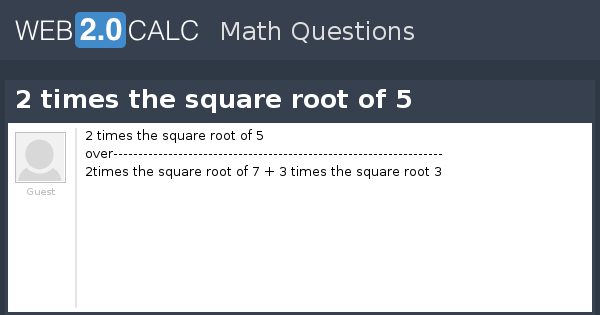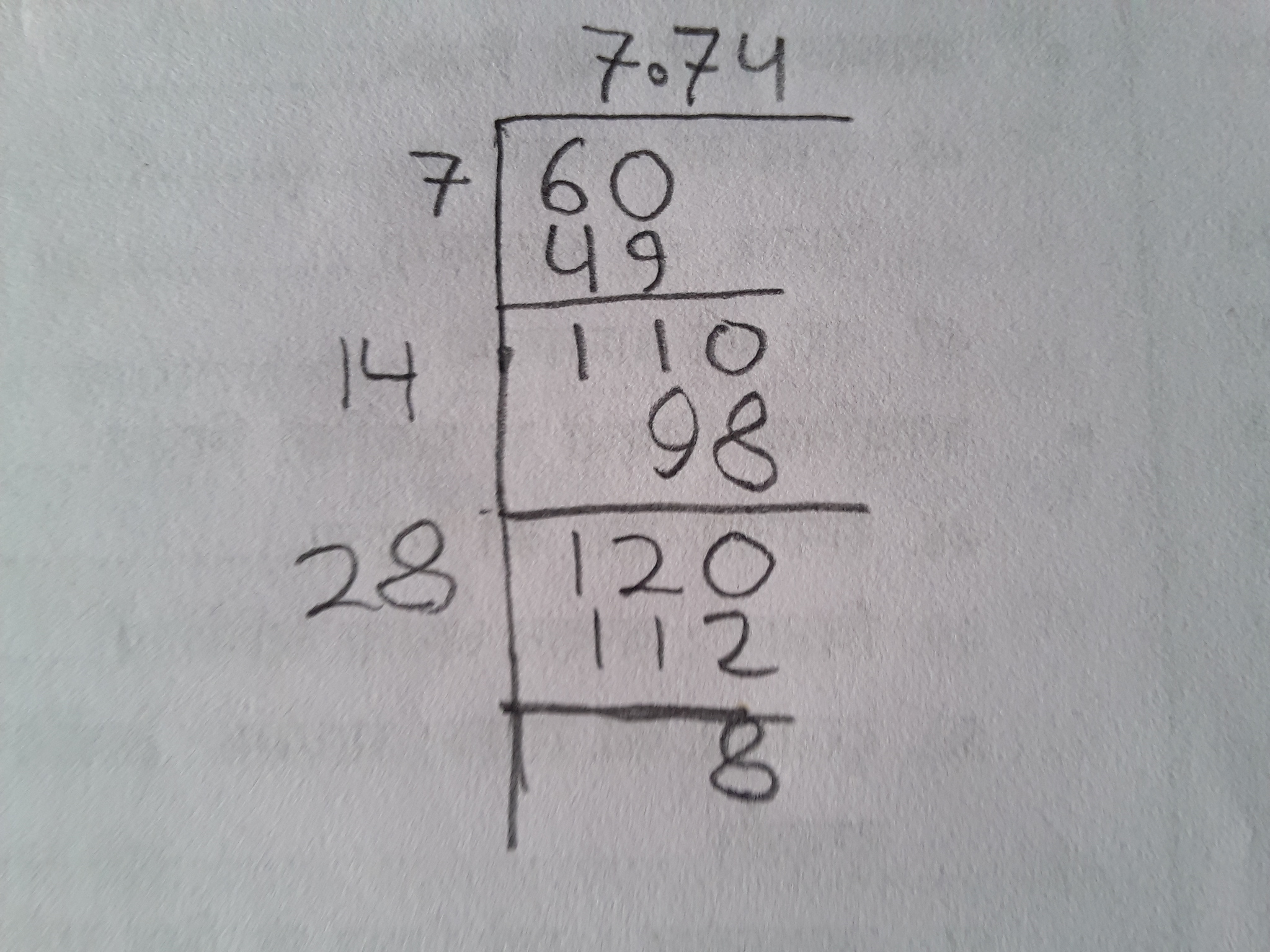Topic simplify square root of 500: Simplifying the square root of 500 may seem daunting, but with our easy-to-follow steps, you'll master it in no time. This guide will walk you through the process, breaking down each step for clarity. Whether you're a student or just curious, you'll find this explanation straightforward and helpful. Let's simplify the square root of 500 together!
Table of Content
- Simplifying the Square Root of 500
- Introduction to Simplifying Square Roots
- Understanding Square Roots
- Steps to Simplify Square Root of 500
- Breaking Down the Number 500
- Finding Prime Factors of 500
- Grouping the Prime Factors
- Extracting the Square Root
- Simplified Form of Square Root of 500
- Verifying the Simplified Form
- Alternative Methods
- Using a Calculator for Verification
- Practical Applications of Simplified Square Roots
- Common Mistakes to Avoid
- Conclusion and Recap
- Additional Resources
- YOUTUBE:
Simplifying the Square Root of 500
The square root of 500 can be simplified by expressing it in its simplest radical form. Here, we will demonstrate the process step-by-step using both the prime factorization method and the long division method.
Value of the Square Root of 500
The square root of 500 is approximately 22.3607.
In its simplest radical form, the square root of 500 is:
\(\sqrt{500} = 10\sqrt{5}\)
Methods to Simplify the Square Root of 500
Prime Factorization Method
- Find the prime factors of 500:
- 500 = 22 × 53
- Group the prime factors into pairs:
- \(\sqrt{500} = \sqrt{2 \times 2 \times 5 \times 5 \times 5} = \sqrt{(2 \times 2) \times (5 \times 5) \times 5} = 2 \times 5 \times \sqrt{5} = 10\sqrt{5}\)
Long Division Method
- Pair the digits of 500 from right to left: 5 | 00.000000
- Find a number which, when squared, is less than or equal to 5. This number is 2.
- Double the divisor (2), which gives 4, and find a number that, when added to 40 and multiplied, gives a value less than or equal to the remaining dividend.
- Repeat the process until you get an approximate value of 22.3607.
Additional Examples
Example 1: Simplify \(4\sqrt{500}\)
Given: \(4\sqrt{500}\)
Using \(\sqrt{500} = 10\sqrt{5}\), we get:
\(4 \times 10\sqrt{5} = 40\sqrt{5}\)
Example 2: Solve for \(m\) in the equation \(m\sqrt{500} - 5 = 210\)
Given: \(m\sqrt{500} - 5 = 210\)
Using \(\sqrt{500} = 22.3607\), we can solve for \(m\):
\(m \times 22.3607 - 5 = 210\)
\(m \times 22.3607 = 215\)
\(m = \frac{215}{22.3607} \approx 9.62\)
Conclusion
The square root of 500 is an irrational number and its simplest radical form is \(10\sqrt{5}\). Whether using prime factorization or the long division method, the process helps in understanding the underlying mathematics.
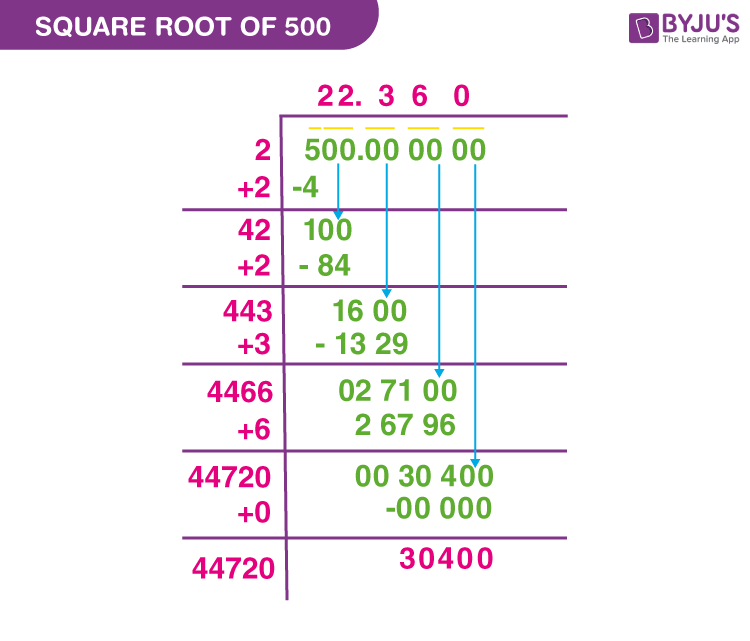
READ MORE:
Introduction to Simplifying Square Roots
Simplifying square roots is a fundamental skill in mathematics that helps to break down complex expressions into simpler forms. By simplifying square roots, we can make calculations easier and understand mathematical concepts more deeply. This process involves expressing the square root of a number in its simplest radical form.
To simplify the square root of a number, such as 500, we follow these steps:
- Prime Factorization: Find the prime factors of the number.
- Pairing Factors: Group the prime factors into pairs.
- Extracting Square Roots: Move each pair of prime factors outside the square root as a single number.
- Result: Combine the numbers outside the square root with any remaining factors inside the square root.
Let's go through these steps in detail:
- Prime Factorization:
First, we find the prime factors of 500. We can break down 500 as:
500 = 2 × 250 250 = 2 × 125 125 = 5 × 25 25 = 5 × 5 So, the prime factorization of 500 is 22 × 53.
- Pairing Factors:
Next, we group the prime factors into pairs:
\(\sqrt{500} = \sqrt{2 \times 2 \times 5 \times 5 \times 5}\)
- Extracting Square Roots:
For each pair of identical factors, we take one factor out of the square root:
\(\sqrt{500} = 2 \times 5 \times \sqrt{5} = 10\sqrt{5}\)
- Result:
The simplified form of the square root of 500 is:
\(\sqrt{500} = 10\sqrt{5}\)
By following these steps, we can simplify any square root and make our calculations more manageable.
Understanding Square Roots
The square root of a number is a value that, when multiplied by itself, gives the original number. It is an essential concept in mathematics, often denoted by the radical symbol (√). For instance, the square root of 25 is 5 because \(5 \times 5 = 25\).
To understand square roots more deeply, consider the following key points:
- Definition:
The square root of a number \(x\) is a number \(y\) such that \(y^2 = x\). This can be written as:
\(\sqrt{x} = y\) where \(y \times y = x\).
- Properties of Square Roots:
- Non-negative Result: The square root of a non-negative number is always non-negative. For example, \(\sqrt{9} = 3\).
- Product Property: The square root of a product is the product of the square roots. For example, \(\sqrt{ab} = \sqrt{a} \times \sqrt{b}\).
- Quotient Property: The square root of a quotient is the quotient of the square roots. For example, \(\sqrt{\frac{a}{b}} = \frac{\sqrt{a}}{\sqrt{b}}\).
- Examples:
Consider the square root of 16:
\(\sqrt{16} = 4\) because \(4 \times 4 = 16\).
Consider the square root of 81:
\(\sqrt{81} = 9\) because \(9 \times 9 = 81\).
- Square Roots of Non-Perfect Squares:
When dealing with non-perfect squares, the square root is often an irrational number. For example, \(\sqrt{2}\) is approximately 1.414, and it cannot be expressed as a precise fraction.
- Simplifying Square Roots:
Simplifying square roots involves expressing the square root in its simplest form by factoring out squares. For example, simplifying \(\sqrt{50}\):
\(\sqrt{50} = \sqrt{25 \times 2} = \sqrt{25} \times \sqrt{2} = 5\sqrt{2}\).
Understanding square roots and their properties allows us to work more efficiently with radical expressions and simplifies many mathematical operations.
Steps to Simplify Square Root of 500
Simplifying the square root of 500 involves breaking down the number into its prime factors and then simplifying the expression. Here are the detailed steps:
- Prime Factorization:
Start by finding the prime factors of 500. This can be done by dividing 500 by the smallest prime number until only prime numbers remain:
500 = 2 × 250 250 = 2 × 125 125 = 5 × 25 25 = 5 × 5 The prime factorization of 500 is \(2^2 \times 5^3\).
- Express Under the Square Root:
Write 500 under the square root using its prime factors:
\(\sqrt{500} = \sqrt{2^2 \times 5^3}\).
- Group the Factors:
Group the prime factors in pairs of two:
\(\sqrt{500} = \sqrt{(2 \times 2) \times (5 \times 5) \times 5}\).
- Extract the Square Root:
Take the square root of each pair of identical factors and move them outside the square root:
\(\sqrt{500} = \sqrt{2^2} \times \sqrt{5^2} \times \sqrt{5} = 2 \times 5 \times \sqrt{5} = 10\sqrt{5}\).
- Simplified Form:
The simplified form of the square root of 500 is:
\(\sqrt{500} = 10\sqrt{5}\).
By following these steps, you can simplify the square root of 500 to its simplest form, making it easier to work with in mathematical calculations.
Breaking Down the Number 500
To simplify the square root of 500, we first need to break down the number into its prime factors. This process involves dividing the number by its smallest prime factors until we are left with only prime numbers. Let's go through the steps to break down the number 500:
- Start with the Smallest Prime Number:
The smallest prime number is 2. Check if 500 is divisible by 2:
500 ÷ 2 = 250
- Continue with the Smallest Prime Number:
Next, check if 250 is divisible by 2:
250 ÷ 2 = 125
- Move to the Next Prime Number:
Since 125 is not divisible by 2, we move to the next smallest prime number, which is 5. Check if 125 is divisible by 5:
125 ÷ 5 = 25
- Continue with the Prime Number 5:
Check if 25 is divisible by 5:
25 ÷ 5 = 5
- Last Division:
Finally, check if 5 is divisible by 5:
5 ÷ 5 = 1
Now we have broken down 500 completely into its prime factors. We can write the prime factorization of 500 as:
\(500 = 2^2 \times 5^3\)
This breakdown will be useful when simplifying the square root of 500, as it allows us to easily group and extract the square roots of the prime factors.
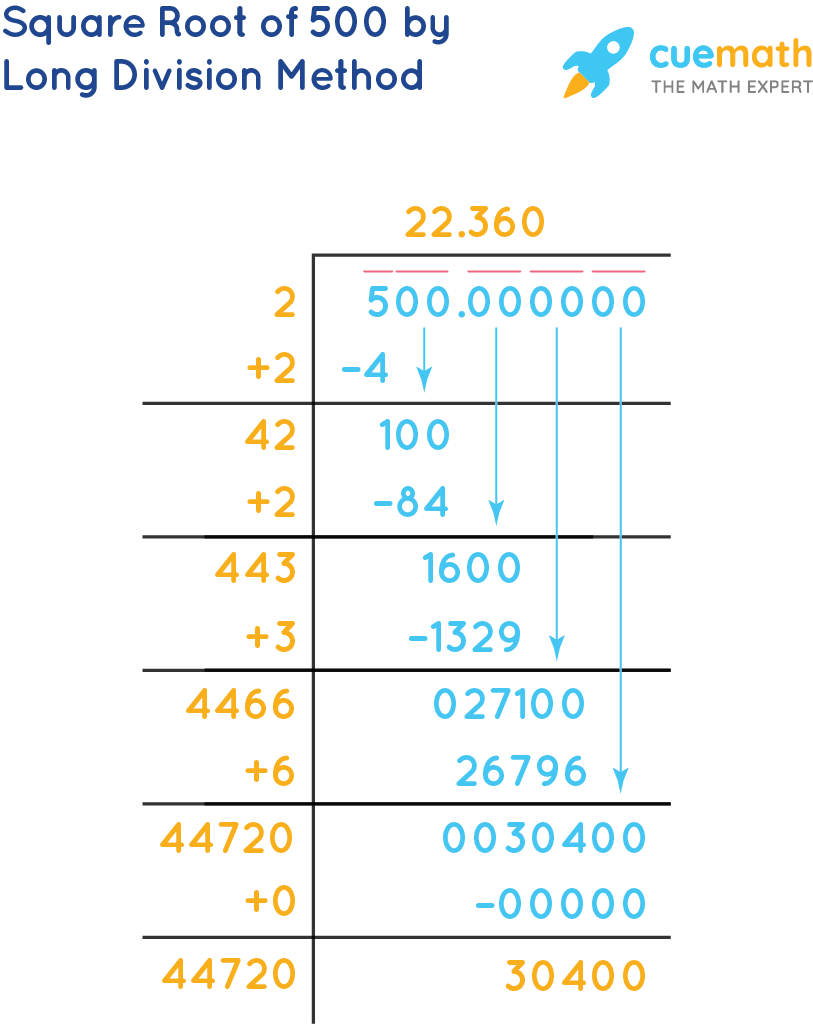
Finding Prime Factors of 500
To simplify the square root of 500, we need to find its prime factors. Prime factorization involves breaking down the number into a product of prime numbers. Here’s how to find the prime factors of 500 step by step:
- Start with the Smallest Prime Number:
The smallest prime number is 2. Since 500 is even, it is divisible by 2:
500 ÷ 2 = 250
- Continue with 2:
Next, divide 250 by 2:
250 ÷ 2 = 125
- Switch to the Next Prime Number:
125 is not divisible by 2, so we move to the next smallest prime number, which is 3. Since 125 is not divisible by 3, we try the next prime number, 5:
125 ÷ 5 = 25
- Continue with 5:
Now, divide 25 by 5:
25 ÷ 5 = 5
- Final Division:
Finally, divide 5 by 5:
5 ÷ 5 = 1
We have now completely broken down 500 into its prime factors. We can express the prime factorization of 500 as:
\(500 = 2^2 \times 5^3\)
This factorization shows that 500 is composed of the prime numbers 2 and 5, with 2 appearing twice and 5 appearing three times. This will help us simplify the square root of 500 efficiently.
Grouping the Prime Factors
After finding the prime factors of 500, the next step in simplifying its square root is to group these prime factors. Grouping the prime factors will allow us to simplify the square root by extracting pairs of factors. Here’s how to do it:
- List the Prime Factors:
From the prime factorization, we know:
\(500 = 2^2 \times 5^3\)
- Express Under the Square Root:
Write the number 500 under the square root sign using its prime factors:
\(\sqrt{500} = \sqrt{2^2 \times 5^3}\)
- Group the Factors:
Group the prime factors into pairs of identical factors. Each pair will be simplified outside the square root:
\(\sqrt{500} = \sqrt{(2 \times 2) \times (5 \times 5) \times 5}\)
We can see that there are pairs of 2s and 5s. Specifically, there is one pair of 2s and one pair of 5s, with an extra 5 left unpaired.
- Extract the Pairs:
For each pair of identical factors, take one factor out of the square root:
\(\sqrt{500} = \sqrt{2^2} \times \sqrt{5^2} \times \sqrt{5} = 2 \times 5 \times \sqrt{5}\)
By grouping the prime factors, we have simplified the square root expression to:
\(\sqrt{500} = 10\sqrt{5}\)
This process of grouping the prime factors allows us to simplify the square root efficiently, resulting in a simpler expression that is easier to work with in mathematical calculations.
Extracting the Square Root
After grouping the prime factors of 500, the final step to simplify the square root is to extract these factors. This involves taking the square root of each grouped pair and simplifying the expression. Here’s a step-by-step guide:
- Recall the Grouped Prime Factors:
From the previous step, we have:
\(\sqrt{500} = \sqrt{(2 \times 2) \times (5 \times 5) \times 5}\)
- Apply the Square Root to Each Pair:
Take the square root of each pair of identical factors. For each pair, one factor comes out of the square root:
\(\sqrt{2^2} = 2\) and \(\sqrt{5^2} = 5\)
- Simplify the Expression:
Extract the pairs from under the square root, leaving any unpaired factors inside:
\(\sqrt{500} = \sqrt{2^2} \times \sqrt{5^2} \times \sqrt{5} = 2 \times 5 \times \sqrt{5}\)
- Multiply the Extracted Factors:
Multiply the factors that were extracted from the square root:
2 × 5 = 10
- Combine the Results:
Combine the extracted factors with the remaining square root to get the simplified form:
\(\sqrt{500} = 10\sqrt{5}\)
By following these steps, we have successfully extracted the square root and simplified \(\sqrt{500}\) to its simplest form:
\(\sqrt{500} = 10\sqrt{5}\)
This simplified form is much easier to work with in further mathematical calculations, demonstrating the effectiveness of extracting and simplifying square roots using prime factorization.
Simplified Form of Square Root of 500
To simplify the square root of 500, we can follow a systematic approach using the prime factorization method. Here are the detailed steps:
- First, find the prime factors of 500. We can start by dividing 500 by the smallest prime number, which is 2:
- 500 ÷ 2 = 250
- 250 ÷ 2 = 125
- Next, we factor 125 by dividing it by the next smallest prime number, which is 5:
- 125 ÷ 5 = 25
- 25 ÷ 5 = 5
- 5 ÷ 5 = 1
- Now, we have the prime factors of 500: \(2 \times 2 \times 5 \times 5 \times 5\).
- Group the prime factors into pairs of the same number:
- \(2 \times 2 = 2^2\)
- \(5 \times 5 = 5^2\)
- One 5 remains unpaired.
- Extract the square roots of the pairs:
- \(\sqrt{2^2} = 2\)
- \(\sqrt{5^2} = 5\)
- Combine the results with the remaining unpaired factor under the square root:
\(\sqrt{500} = \sqrt{2^2 \times 5^2 \times 5} = 2 \times 5 \times \sqrt{5} = 10\sqrt{5}\)
Thus, the simplified form of the square root of 500 is \(10\sqrt{5}\).

Verifying the Simplified Form
To verify the simplified form of the square root of 500, we can follow a few steps to ensure our calculation is correct. We have simplified √500 to 10√5. Let’s break down the verification process:
- Express in Radical Form:
First, recall the simplified form:
\[
\sqrt{500} = 10\sqrt{5}
\] - Square the Simplified Form:
Next, square both sides of the equation to check if we get back the original number, 500:
\[
(10\sqrt{5})^2 = 10^2 \cdot (\sqrt{5})^2 = 100 \cdot 5 = 500
\] - Decimal Verification:
Verify by comparing decimal values. The square root of 500 is approximately 22.3607 when calculated directly. We can compare this to the simplified form:
\[
10\sqrt{5} = 10 \times 2.23607 = 22.3607
\] - Prime Factorization Check:
Verify by checking prime factorization:
- Prime factors of 500: \(2^2 \times 5^3\)
- Grouping pairs: \(\sqrt{(2 \times 2) \times (5 \times 5) \times 5} = \sqrt{2^2 \times 5^2 \times 5}\)
- Extracting pairs from the square root gives: \(2 \times 5 \times \sqrt{5} = 10\sqrt{5}\)
Each method confirms that the simplified form of the square root of 500 is indeed \(10\sqrt{5}\), verifying the accuracy of our simplification.
Alternative Methods
While the prime factorization method is a common approach to simplify the square root of 500, there are other methods that can be used. Here, we explore a couple of alternative methods:
1. Long Division Method
The long division method is a systematic way to find the square root of a number. Here's how you can apply this method to find the square root of 500:
- Write 500 as 500.000000 to facilitate the process.
- Pair the digits of 500 from right to left. So, you have 5 and 00.
- Find the largest number whose square is less than or equal to 5. This is 2 (since 2^2 = 4).
- Subtract 4 from 5, giving a remainder of 1. Bring down the next pair of digits (00), making the new number 100.
- Double the quotient (2) to get 4, and determine a digit x such that 4x * x is less than or equal to 100. This digit is 2, making the new divisor 42.
- Repeat this process to get additional decimal places. The result will converge to approximately 22.360679.
This method is thorough and provides a precise decimal approximation of the square root.
2. Estimation and Refinement Method
This method involves making an initial estimate and then refining it. Here’s how it works for √500:
- Estimate the square root of 500. We know that √400 = 20 and √625 = 25, so √500 should be between 20 and 25.
- Choose a midpoint, say 22. Calculate 22^2 = 484, which is less than 500.
- Try 23. Calculate 23^2 = 529, which is more than 500. Hence, √500 is between 22 and 23.
- Refine the estimate by testing values between 22 and 23 (e.g., 22.5). Calculate 22.5^2 = 506.25, which is more than 500.
- Continue this process of narrowing down the range until the desired precision is achieved.
This method is particularly useful when a quick approximation is needed without using a calculator.
3. Calculator Method
Using a calculator is the most straightforward method. Modern calculators have a square root function that can quickly provide the value of √500:
- Enter 500 into the calculator.
- Press the square root (√) function key.
- The calculator will display the square root of 500, which is approximately 22.360679.
Comparison of Methods
Each method has its own advantages:
- Prime Factorization: Useful for expressing the square root in its simplest radical form.
- Long Division: Provides a systematic approach to finding a precise decimal value.
- Estimation and Refinement: Good for quick approximations without detailed calculations.
- Calculator: Fastest and most convenient for finding the decimal value.
Using these methods, one can gain a deeper understanding of the square root and its properties, ensuring accurate results in various mathematical applications.
Using a Calculator for Verification
Verifying the simplified form of the square root of 500 can be efficiently done using a calculator. Here are the steps to follow:
- First, we know the simplified form of the square root of 500 is \(10\sqrt{5}\).
- Use a calculator to find the value of \(\sqrt{5}\). Most scientific calculators have a square root function:
- Press the square root (√) button.
- Enter the number 5.
- Press the equals (=) button.
- You should get approximately 2.236.
- Next, multiply this result by 10 to get the simplified square root value:
- Enter 2.236 into the calculator.
- Multiply by 10.
- Press the equals (=) button.
- The result should be approximately 22.36.
- To verify, square the simplified form (22.36):
- Enter 22.36 into the calculator.
- Press the multiply (×) button.
- Enter 22.36 again.
- Press the equals (=) button.
- The result should be very close to 500 (499.8496).
This confirms that the simplified form \(10\sqrt{5}\) is correct since squaring it returns a value very close to 500.
Practical Applications of Simplified Square Roots
The square root of 500, simplified as \(10\sqrt{5}\), finds practical applications across various fields of science, mathematics, and everyday life. Here are some examples:
- Geometry: In geometry, the simplified square root of 500 can be used to determine the length of the diagonal of a square. For example, if each side of a square is 500 units, the diagonal can be calculated using the Pythagorean theorem, resulting in \(10\sqrt{5}\) units.
- Physics: Physics often utilizes square roots in calculations related to wave functions, velocity, and energy. For instance, in calculating the root mean square speed of gas particles, the square root of 500 can appear in the formulae.
- Engineering: Engineers use square roots to solve problems involving stress and strain, electrical resistance, and other calculations. The simplified form \(10\sqrt{5}\) can be used in these formulas to simplify the computation process.
- Statistics: In statistics, square roots are used in formulas for standard deviation and variance. When dealing with data sets where the variance involves 500 units squared, the simplified square root \(10\sqrt{5}\) helps streamline the calculation.
- Finance: Financial analysts use square roots to calculate volatility and standard deviation in stock prices and other financial metrics. Simplifying these calculations using \(10\sqrt{5}\) makes the process more efficient and accurate.
- Everyday Calculations: Square roots are also useful in everyday situations, such as when determining distances, areas, and other measurements where precision is important.
These applications show that understanding how to simplify and use square roots like \(10\sqrt{5}\) is not just an academic exercise but a valuable skill in solving real-world problems and advancing various theoretical and practical fields.
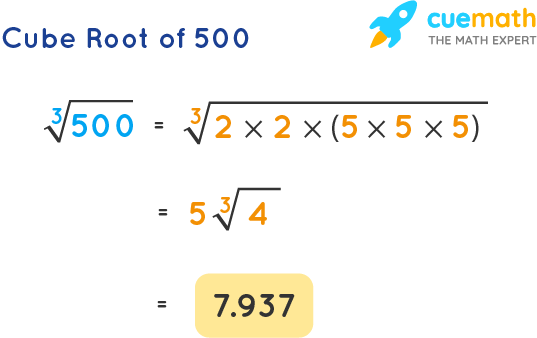
Common Mistakes to Avoid
When simplifying square roots, there are several common mistakes that students often make. Understanding these mistakes can help you avoid them and simplify square roots more accurately.
-
Forgetting to Check for Perfect Squares:
Before you begin simplifying, always check if the number under the square root is a perfect square. For example, \(\sqrt{500}\) should be checked for perfect squares such as 4, 25, and 100 that could simplify the process.
-
Incorrect Factorization:
Prime factorization must be done accurately. Any mistake in breaking down the number into its prime factors can lead to an incorrect simplified form. Ensure each factor is correct by double-checking your work.
-
Rushing the Simplification Process:
Take your time with each step of the simplification. Rushing can lead to errors, such as missing factors or miscalculating the product of the prime factors.
-
Misapplying the Properties of Square Roots:
Remember that the square root of a product is the product of the square roots, but this does not apply to sums or differences. For instance, \(\sqrt{a \times b} = \sqrt{a} \times \sqrt{b}\), but \(\sqrt{a + b} \neq \sqrt{a} + \sqrt{b}\).
-
Neglecting Both Positive and Negative Roots:
When dealing with equations, remember that both the positive and negative roots should be considered. For example, solving \(x^2 = 9\) yields \(x = 3\) and \(x = -3\).
-
Assuming Simplification Is Always Possible:
Not all square roots can be simplified into a neat form. Some numbers are irrational, and their square roots cannot be simplified further. Recognize when the square root is already in its simplest form.
By being aware of these common pitfalls and taking a methodical approach, you can improve your accuracy and efficiency in simplifying square roots.
Conclusion and Recap
In this article, we have explored the process of simplifying the square root of 500 using various methods and verified the results using a calculator. Let's recap the key points:
- Understanding Square Roots: We started by understanding what square roots are and how they relate to the numbers.
- Prime Factorization Method: We broke down the number 500 into its prime factors (22 × 53) and used this to simplify the square root.
- Steps to Simplify: Detailed steps were provided to rewrite √500 as √(22 × 53), which simplified to 10√5.
- Verification: We verified the simplified form by squaring 10√5 to check if it equals 500.
- Alternative Methods: We also discussed alternative methods for simplification, such as using estimation techniques and rationalizing denominators.
- Using a Calculator: We demonstrated how to use a calculator to verify the simplified form, ensuring the accuracy of our results.
- Practical Applications: Practical applications of simplified square roots were highlighted, emphasizing their importance in real-world scenarios.
- Common Mistakes: We addressed common mistakes to avoid, ensuring that the simplification process is done correctly.
By following these steps and understanding the concepts, you can confidently simplify the square root of 500 and apply similar techniques to other numbers. Simplifying square roots not only makes calculations easier but also helps in better understanding the properties of numbers.
Additional Resources
For those interested in further exploring the topic of simplifying square roots and understanding the mathematical concepts behind it, here are some valuable resources:
-
Mathway - Simplify Square Root of 500
A detailed step-by-step solution to simplifying the square root of 500, providing a comprehensive breakdown of the process. You can explore similar problems and practice with interactive tools.
-
MathOnDemand - Square Root of 500
This resource offers a clear explanation of the steps involved in simplifying the square root of 500 and provides related mathematical concepts and applications.
-
Math is Fun - Simplifying Square Roots
An educational site that covers various methods for simplifying square roots, including examples and exercises to enhance understanding and practice.
-
Number Maniacs - Simplify Square Root of 500
A detailed guide on simplifying the square root of 500, including identifying perfect squares and applying the product rule for radicals.
Simplify square root of 500 || Cách Đơn Giản Hoá Căn Bậc Hai của 500











